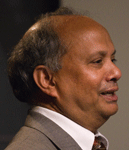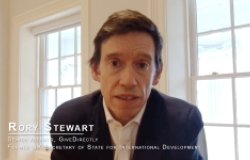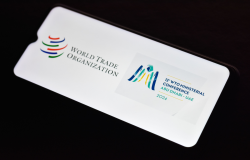Washington, DC Launch of Africa: Atlas of Our Changing Environment
"We're not just talking about environmental change as an isolated phenomenon, but what are its implications to development, to people, to the future of the economy, and ultimately to the sustainability of resource use?" says UNEP's Achim Steiner at the Washington, DC launch of the Atlas.
Overview
Recently released to wide acclaim, Africa: Atlas of Our Changing Environment "is not just an illustration of environmental change in the negative sense. It has, in these pages, many examples of how a deliberate policy choice by government leaders, by communities, or by them working together, allowed for a very different outcome," said Achim Steiner, executive director of the UN Environment Programme (UNEP). At the Washington, DC, launch of the atlas, sponsored by the Woodrow Wilson Center's Environmental Change and Security Program on July 1, 2008, Steiner was joined by Ashbindu Singh, regional coordinator for early warning and assessment at UNEP's Regional Office for North America, Daniel Reifsnyder, deputy assistant secretary for environment at the U.S. Department of State's Bureau of Oceans and International Environmental and Scientific Affairs, and Hennie du Toit, counsellor of political affairs at the Embassy of the Republic of South Africa in Washington, DC.
A Rallying Cry
 The atlas, a wide-ranging photographic review of dramatic environmental change in Africa over the past 30 years, serves as a wake-up call for African and international policymakers. Yet UNEP also designed the atlas to show how prudent and innovative policies can reverse ecological harm—showing, for instance, the restoration of wetlands surrounding Mauritania's Diawling National Park. "So often, the news on the environmental front is negative," said Reifsnyder, but "it's important not to lose sight of the actions we can take that make a difference."
The atlas, a wide-ranging photographic review of dramatic environmental change in Africa over the past 30 years, serves as a wake-up call for African and international policymakers. Yet UNEP also designed the atlas to show how prudent and innovative policies can reverse ecological harm—showing, for instance, the restoration of wetlands surrounding Mauritania's Diawling National Park. "So often, the news on the environmental front is negative," said Reifsnyder, but "it's important not to lose sight of the actions we can take that make a difference."  The hope is that, as du Toit put it, "this atlas will be a rallying cry to Africans and the international community alike so that no one can say that they did not see with their own eyes the effects of environmental degradation and the need for urgent action."
The hope is that, as du Toit put it, "this atlas will be a rallying cry to Africans and the international community alike so that no one can say that they did not see with their own eyes the effects of environmental degradation and the need for urgent action."
The creators of the atlas decided that it would be most compelling to tell a series of stories, rather than repeat a litany of statistics. As Steiner put it, "In a world of climate change and IPCCs, we've become all but too used to the fact that we can always talk about the world in its totality." Yet those macro-level discussions provide little help to local authorities struggling to make a difference with their limited resources. UNEP chose to highlight local-level examples—like that of Diawling—from every African country in an attempt to make the atlas valuable to local African authorities.
Images Reveal Transcontinental Threats
The atlas's 316 satellite images, 151 maps, and 319 ground photos document widespread environmental change in every African country. Deforestation is a major environmental threat in 35 African countries, as are dwindling biodiversity (34 countries), erosion and land degradation (32 countries), overfishing and coastal degradation (23 countries), pollution (21 countries), water scarcity (21 countries), and desertification (18 countries). Steiner highlighted the links between water stress and population: "We are talking about a continent where we are close to a billion people, of whom, for instance, 300 million already live under conditions of water stress, either seasonally or permanently. That is a third of Africa's population."
"Africa is losing more than four million hectares of forest every year, twice the world's average deforestation rate," said Steiner. Yet unlike the Amazon, where large-scale incursions by agricultural enterprise and industrial logging are responsible for deforestation, Africa's forests face much more decentralized pressures from local farmers and communities.
Steiner also explained that "erosion and chemical and physical damage have degraded about 65 percent of the continent's farmland." In addition to threatening Africa's ability to feed itself, degradation of arable land is "contributing to the potential for conflict," said Steiner, by sparking land and resource disputes and forcing migration.
Not a Coffee Table Book
 Currently available for free on UNEP's website, the atlas will soon be incorporated into Google Earth and other websites to maximize its availability and influence. Said Singh, "It's not just a coffee table book; it has to make some impact." Steiner added, "We're trying to also link the discussion of environmental change to the Millennium Development Goals. So we're not just talking about environmental change as an isolated phenomenon, but what are its implications to development, to people, to the future of the economy, and ultimately to the sustainability of resource use?"
Currently available for free on UNEP's website, the atlas will soon be incorporated into Google Earth and other websites to maximize its availability and influence. Said Singh, "It's not just a coffee table book; it has to make some impact." Steiner added, "We're trying to also link the discussion of environmental change to the Millennium Development Goals. So we're not just talking about environmental change as an isolated phenomenon, but what are its implications to development, to people, to the future of the economy, and ultimately to the sustainability of resource use?"
Steiner described a flight he took with the Kenyan prime minister and minister of environment in a small plane over the Mau Forest Complex, which is being decimated by illegal logging and settlements. Taking the leaders of the country "flying above it, seeing it, seeing the sheer scale of destruction, has led now to one of the major initiatives to save this ecosystem," said Steiner, who hopes the atlas will serve the same catalyzing function across the continent.
Drafted by Daniel Gleick and edited by Rachel Weisshaar.
Documents & Downloads
- Washington, DC Launch of Africa: Atlas of Our Changing EnvironmentDownload
- Washington, DC Launch of Africa: Atlas of Our Changing EnvironmentDownload
- Washington, DC Launch of Africa: Atlas of Our Changing EnvironmentDownload
- Washington, DC Launch of Africa: Atlas of Our Changing EnvironmentDownload
- Washington, DC Launch of Africa: Atlas of Our Changing EnvironmentDownload
- Washington, DC Launch of Africa: Atlas of Our Changing EnvironmentDownload
- Washington, DC Launch of Africa: Atlas of Our Changing EnvironmentDownload
- Washington, DC Launch of Africa: Atlas of Our Changing EnvironmentDownload
Speakers
Achim Steiner
Daniel A. Reifsnyder
Hennie du Toit
Ashbindu Singh
Hosted By

Environmental Change and Security Program
The Environmental Change and Security Program (ECSP) explores the connections between environmental change, health, and population dynamics and their links to conflict, human insecurity, and foreign policy. Read more

Africa Program
The Africa Program works to address the most critical issues facing Africa and US-Africa relations, build mutually beneficial US-Africa relations, and enhance knowledge and understanding about Africa in the United States. The Program achieves its mission through in-depth research and analyses, public discussion, working groups, and briefings that bring together policymakers, practitioners, and subject matter experts to analyze and offer practical options for tackling key challenges in Africa and in US-Africa relations. Read more
Thank you for your interest in this event. Please send any feedback or questions to our Events staff.










